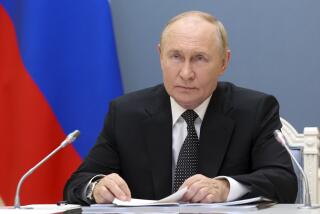Reports Detail Cycle of Violence in Kosovo
- Share via
SARAJEVO, Bosnia-Herzegovina — NATO’s intervention to end the brutal repression of ethnic Albanians in Kosovo has failed to stop a vicious cycle of violence in which even children are taking part, human rights investigators reported Monday in the most detailed look yet at Kosovo’s war.
Ethnic Albanian children as young as 10 are being used by adults to carry out attacks on Serbs and other minorities, the Organization for Security and Cooperation in Europe said in two lengthy reports.
The OSCE also found evidence that fighters of the disbanded Kosovo Liberation Army, or KLA, which led the struggle for independence from Yugoslavia, are responsible for killings, kidnappings and other crimes against Serbs and other minorities.
But Bernard Kouchner, the U.N. administrator of Kosovo, lays overwhelming blame for the continuing ethnic conflict in the province on years of oppression by the Serbs.
“Some Kosovo Serbs were victims of Kosovo Liberation Army violations of humanitarian law, but there was nothing close to equivalence; the Yugoslav and Serbian military, police and security services targeted Kosovo Albanians,” Kouchner wrote in a forward to one of the reports. “Executions, arbitrary arrests, torture, rape and other forms of sexual violence, and forced expulsions characterized the Yugoslav and Serb forces’ campaign to expel Kosovo Albanians to other states.”
Kosovo is a southern province of Serbia, and while it formally remains part of Yugoslavia, the majority of ethnic Albanians want independence.
Investigators said it was not clear whether Yugoslav President Slobodan Milosevic planned to expel all ethnic Albanians from Kosovo, to reduce the population “to a manageable number,” or to clear out all areas where KLA rebels were present and had strong support.
The reports by the OSCE, an organization that includes the United States, are based on investigations by 78 human rights workers who interviewed more than 3,000 refugees and eyewitnesses. They offer the most extensive look to date at the complexities of the war.
The first report details abuses from December 1998 until June, when Kosovo’s ethnic Albanian majority suffered most under what the investigators found was a systematic campaign to expel hundreds of thousands of people. That period included the North Atlantic Treaty Organization’s bombing campaign against Yugoslavia.
The second concentrates on the months after a NATO-led peacekeeping force occupied Kosovo, and Serbs and other minorities came under attack by ethnic Albanians. One of the most alarming trends in Kosovo today is “the increasing participation of juveniles in human rights violations,” Kouchner wrote.
Investigators found “case after case of young people, some only 10 or 12 years old, harassing, beating and threatening people, especially defenseless elderly victims, solely because of their ethnicity,” he said.
Sometimes, adults cynically use children to carry out attacks because the NATO-led peacekeeping force, known as KFOR, has no facility to detain juveniles, Kouchner added.
Many times, the investigators found evidence that ethnic Albanians and Serbs committing violence after the NATO-led force arrived belonged to armed groups that “seem to operate in an organized fashion and have some form of hierarchy, command and control.”
While detailing many violations of the laws of war down to the killing of farm animals, the reports also describe an ongoing civil war escalated by NATO’s air campaign and suggest a brutal military logic was behind the Serbian onslaught.
An offensive aimed at quickly crushing the KLA “meant the forced displacement of Kosovo Albanians in known KLA areas, and the pursuit of [refugees] in the hills, particularly the targeting of men of fighting age,” the report said.
While providing extensive evidence of a systematic campaign by Serbian police, soldiers and paramilitaries to kill, loot and rape while expelling more than 800,000 ethnic Albanians, the human rights investigators also found several startling examples of Serbian civilians and Yugoslav soldiers who risked their lives to save ethnic Albanians.
One Yugoslav army soldier prevented six others from killing a Kosovo Albanian man who returned to his house in the northern village of Donje Ljupce, near Podujevo, at the end of April, the report said.
But the OSCE reports also confirm that volunteer units, which were supposed to be part of the regular chain of command, at times broke ranks and committed crimes.
More to Read
Sign up for Essential California
The most important California stories and recommendations in your inbox every morning.
You may occasionally receive promotional content from the Los Angeles Times.













